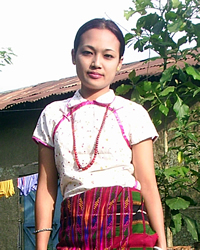The Zou / Zo are a Tibeto-Mongoloid group of people, a sub-family of the Chin-Kuki-Mizo race. They form a group of Tibeto-Burman peoples inhabiting the Chin Hills in Mynamar and Manipur in India. They are also recorded as Yo and Jou by many colonial civil servants and modern writers.
The earliest historical records of the Zo were written by Fan-Cho a diplomat of the Tang dynasty of China, who mentioned a kingdom in Chindween valley whose princes and chiefs were called Zo, Shou, or Zhou in the year 862 A.D.
The most accurate historical records of the Zos/Zous were written by Rev. Fr. Vincentious Sangermano, a Roman Catholic missionary who came to Burma in 1783 A.D. He wrote a book entitled "A Description of the Burmese Empire", which was published in 1835 A.D in Rome in the Latin language. Later on it was translated into English by William Tandy D.D.
"To the east of the Chien Mountains is a pretty nation called 'Jou'. They are supposed to have been Chein, who in the progress of time have become Burmanized, speaking their language, although very corruptly, and adopting all their customs."
Betram S. Carey CIE, Assistant Commissioner, Burma, and Political Officer, Chin Hills and H. N. Tuck, Extra Assistant Commissioner, Burma and Assistant Political Officer, Chin Hills wrote 'The Chin Hills'. In that book, Volume I, page 140, they wrote about the Zos as follows:
"The Yos (Zos) tribe three generations back occupied the tract now occupied by the Kanhow clan of Soktes, and many of the Kanhow villages are inhabited still by Yos, whose tribal name has given way to that of Kanhow. As has been shown in the previous chapter, Kantum, the Sokte, conquered all the inhabitants right up to the borders of Manipur, and Kanhow, his son, founded Tiddim village and ruled the newly acquired conquests of his father. The conquered Yos thus became known as Kanhowte, Kanhow's men, and as they intermarried with the Soktes who settled north with Kanhow, there is no real difference between the conquerors and the conquered".
"While all clans and families belonging to the tribe who call their chief Topa designated themselves by 'Yo' or 'Zo', they in turn apply their common name to a particular clan. The Yos (Zos) are most unique in the sense of the name they bear and the culture they practice in reflection of the ancient Zo tradition" ... No proper study has yet been made as to why the generic Yo as spelt in former literature was applied to them".
The use of the term Zou can be traced back by comparative linguistic and cultural studies to some Chinese roots or other related Southeast Asian cultural complex. Preliminary enquiry suggests that there is a tribe bearing the name 'Yao' in the Lingnan region (Kwangtung - Kwangsi) of China, which is described as 'a center of dispersal for the Yao of Yunnan and northern Southeast Asia'. Lebar, et al. informed us that Kwangsi contained more Yao than any other Chinese province. Yao settlements are mainly concentrated in a series of mountain backwater areas and they are ethnic islands surrounded by Chinese culture. Their linguistic position is uncertain, but they are frequently classified as Sino-Tibetan by linguists. The description of the Yao of the Lingnam region and Yunnan province in China interestingly tallies with the cultural characteristics of the Zous in Manipur and Myanmar at many points.
While colonial records referred to the Zou tribe variously as 'Yo' or 'Yaw', the Zou community living in Manipur called itself 'Jou'. The first Christian church established by the Zou tribe in Manipur was called Jou Christian Association (JCA), founded 20 February 1954. But the government of India officially recognized the name of this tribe as 'Zou' in 1956.
The term 'Zo' has been employed in many books written by the Zou to denote the word 'Zou', for simple reason of phonetic usage. The first complete version of the Holy Bible in the Zo language (1983) used the title 'The Holy Bible in Zo' and the second complete Holy Bible used the word 'Zokam'. T. Gougin used the terminology Zo and Zomi to denote this community in the book 'A Brief History of Zou' (1961) and Pu. Thangkhanlal also used the term 'Zo' in his Zo primer (1973), and others.
The Zou themselves employ the various terms Zo, Zou, and Zomi to mean their tribe. The Zos in India really do not bother whether they use Zo, Zou, or Zomi to denote themselves.
The term 'Zou' is officially accepted as referring to the Zou tribe in Manipur, since 1956. We also find that the term 'Zomi' is used to connote the word 'Zou people' as evident in the terminology used by the main political organization of the Zou people in Manipur, which is called United Zomi Organisation (UZO). [David Lalpi, Zo Scholar]. But in Myanmar (Burma) these very same people have been using the term 'Zo' to denote themselves in Chin Hills and in the Sagaing division of Myanmar since the beginning of Roman script for writing, perhaps as early as the 1920s. The name 'Zo' has been used by them since time immemorial. They also founded Zo Baptist Association (ZBA) by dissociating themselves from the parent body Zomi Baptist Convention (ZBC) which is mainly constituted by the Tedim-Chins and other Chin groups.
Scripture Prayers for the Zo in Myanmar (Burma).
| Profile Source: Anonymous |











